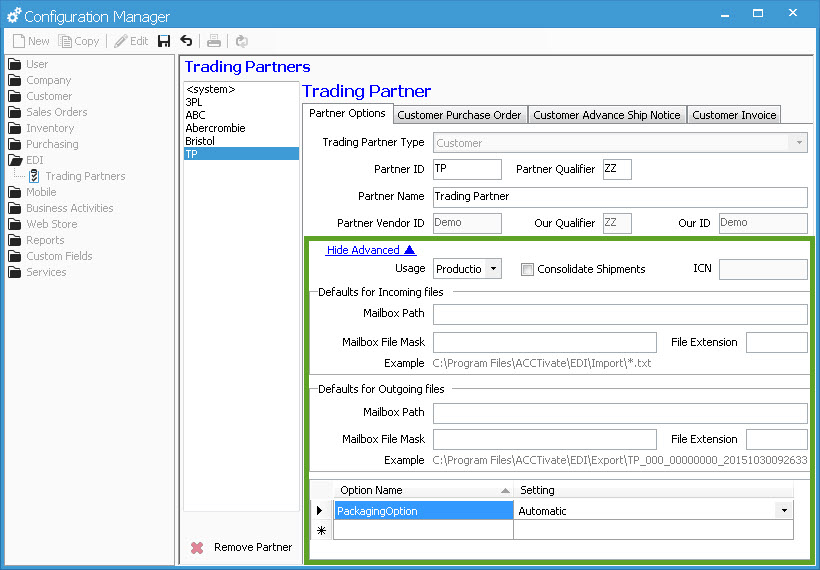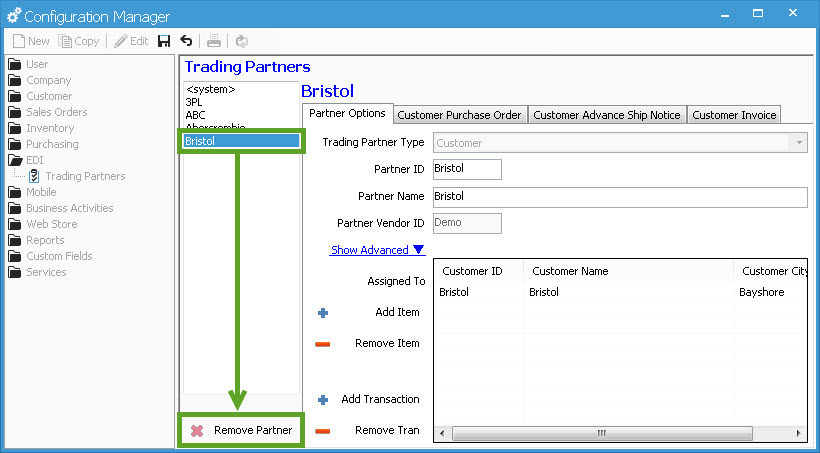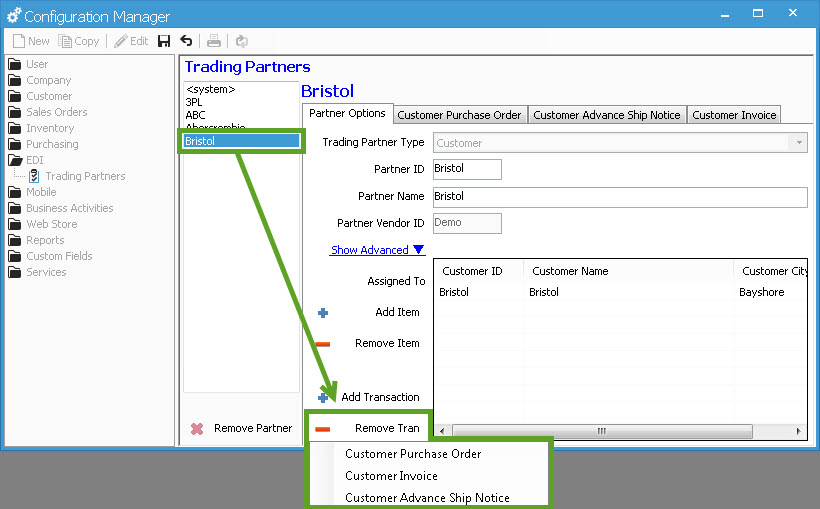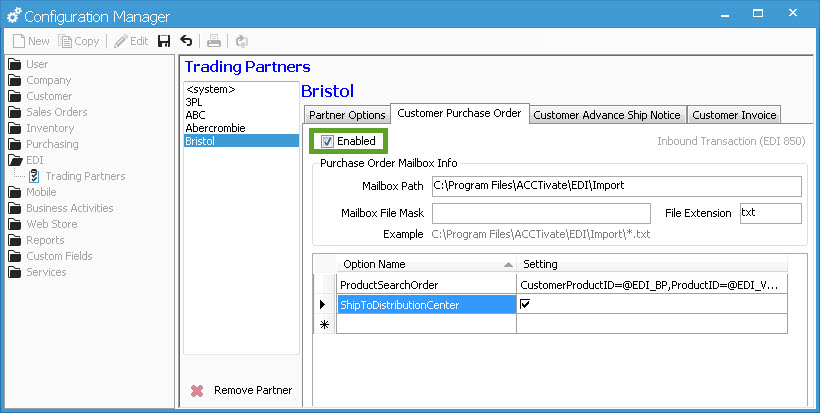Adding and modifying EDI trading partners
The step by step guide you need for setting up new trading partners or adjusting existing ones. You will need to first obtain a license for the EDI trading partner from your Acctivate sales rep.
There are two types of Trading Partners in Acctivate – Customer and Warehouse. Below you will find detailed instructions on how to create or edit an EDI Trading Partner in Acctivate. If you’re wanting to Edit an existing trading partner, this article explains all the available options as it goes through creating a new one. Check out the EDI webinar for an in depth demo on how to set this up.
- Go to File > Configuration Management > EDI > Trading Partners
- To add a new partner, click New. To edit an existing partner, select the partner in question and click Edit.

Customer Trading Partner
- After following the steps above by clicking New, select the Trading Partner Type of Customer
- Give the new partner a Partner ID. This is the short name found in the EDI Transaction files.
- Assign a Partner Name which is typically the full customer name

- Save the new partner
- Click Add Item to add assign this new trading partner to a customer in Acctivate using the lookup window. If you are needing to assign multiple customers to this trading partner, you’ll need to make sure the ship to locations match up to the store numbers being sent in the EDI transaction files.
- To add the specific documents, click Add Transaction and select the proper transaction files. Do this for each type of file you require – Customer Purchase Order, Customer Advance Ship Notice, or Customer Invoice.

- For more options, click Show Advanced

- Leave Partner Qualifier as ZZ unless instructed otherwise
- The Partner Vendor ID, Our Qualifier, Our ID, and ICN cannot be updated.
- Usage will be set to Production or Testing depending on where you are in the EDI implementation with your EDI provider.
- If you need to Consolidate Shipments, check the box.
- The Defaults for Incoming and Outgoing Files will default based on the information specified in the <system> trading partner. You can override this value if the file paths are different from the default in this section. To override the Mailbox File Mask, double-click in the field to see available fields to pull from the trading partner setup or type what should always be listed.
To set up FTP mailbox paths, follow this guide. - If the File Extension is different from the <system>, enter it in this section.
- You can set specific options in the Option Name/Setting section. The available options are:
- Packaging Option – Automatic, Single Carton, or No Auto Packaging. This tells Acctivate how to handle the Trading Partner orders in Packaging Manager. For more information on these options, go to this article.
- Store as Alternate Customer ID – check the box if you wish to store as the alternate Customer ID.
- The remaining steps go through each Customer Transaction for EDI. As always, the Mailbox Path, File Mask, and File Extension default to what’s setup in the <system>trading partner. Users can override when it needs to be a different value than the default. You can also enable or disable the transaction file, if necessary:
- Customer Purchase Order (850) Options:
- Product Search Order – The default search order is Customer Product ID (BP) >Product ID (VP) > Product UPC (UPC) > Alternate Product ID (VP). If the 850 does not include a matching product record, you will see a warning in the EDI tool.
- Ship To Distribution Center – Yes or No depending on whether you’re shipping to a distribution center for your trading partner

- Customer Advance Ship Notice (856)
- Include SSCCAI – This tells Acctivate to include the SSCC application identifier in the 856 ASN transaction file export. This will add a prefix of '00', changing the 18 digit SSCC code to 20 digits.
- Shipment Structure – Choose Pick & Pack (SOPI), Standard Pack (SOIP), or No Pack (SOI) based on the specifications of your trading partner. Check out our help article on these structures to see what is included.
- Customer Invoice (810)
- Invoice Selection – EDI Only will prompt Acctivate to only create 810 documents for orders created via the EDI tool. Include All will create an 810 document for any order for the customer assigned to the trading partner regardless of how it was created.
- Customer Purchase Order (850) Options:
- Save when complete
Warehouse Trading Partner
- After clicking New, select a Trading Partner Type of Warehouse.

- Give the new partner a Partner ID, Partner Name and Save the new Partner.
- Click Add Item to select an Acctivate Warehouse to assign to the new 3PL
- Select Add Transaction to add the Warehouse Order and Warehouse Shipment transactions
- Show Advanced to update any Mailbox Path, File Mask, or File Extensions for these transactions
If the Mailbox Path uses an FTP folder, review this guide for setup. - The following information lists the different options for the 3PL Warehouse documents. As always, you can override the Mailbox Path, File Mask, and File Extension for each transaction, if different than <system>:
- Warehouse Order (940)
- Filter Orders By Work Flow – By default, the Warehouse Orders will only pull orders with a work flow status of Ready to Pick. If you want to use a different work flow status, choose it here.
- Order Work Flow Status – Choose the work flow status to use after you’ve created the 940 and sent to your warehouse.
- Warehouse Shipment (945) – The only thing you can modify for this document is the Mailbox Path, File Mask, or File Extension.
- Warehouse Order (940)
- Save when complete
Delete or Disable Trading Partner
There are three ways to remove the transaction files from the EDI tool.
- Remove Partner – Only allowed when trading partner not listed on any Acctivate transactions

- Remove Transaction – From the Partner Options screen, click Remove Tran and select the EDI transaction you wish to remove from the partner.

- Disable – If the trading partner is listed on transactions, you’ll need to disable the transactions themselves. We block deleting trading partners with history. Go into each Transaction and uncheck the Enabled box.
